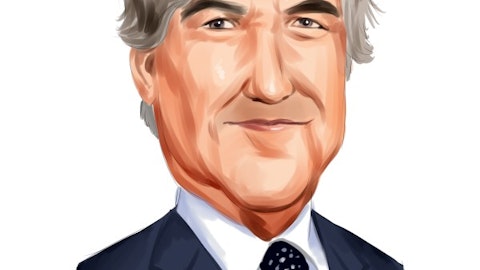David Morimoto: Our baseline forecast — our internal baseline forecast has [three 25] basis point cuts in 2024, but not being in the first quarter. So again, I think the important thing to note on the net interest margin is the interest rate swap, the forward starting interest rate swap that we put in, in early 2020. So it goes live in April 1, 2024. And again, we’re paying fixed at [210] and we’re receiving Fed funds floating. So at the current time, we’re 340 basis points in the money on 115 million. So by our forecast, if there are the [three 25] basis points cuts in 2024, the swap will add 1.8 million in net interest income, 2 basis points to NIM, $0.05 to EPS.
Operator: [Operator Instructions] And our next question comes from the line of Andrew Liesch with Piper Sandler.
Andrew Liesch: So just to touch base on the kind of the repositioning of the securities and the $2 million — and then the offices as well, $2 million. How much of that do you think it’s going to flow to the bottom line versus redeploy or reinvest it back into the franchise?
Arnold Martines: Andrew, that’s a good question for David.
David Morimoto: Again, like all banks, we continue to invest in the franchise. As you know, Andrew, we’ve had multiple technology initiatives. First, we started with customer facing technology enhancements. More recently, we’ve been focused on the back office with some new software implementations. So I think the way to answer your question is it likely won’t all flow to the bottom line. But what I would probably guide you to is our quarterly run rate guidance on [OE]. So we’re still guiding to $40 million to $41 million per quarter or full year 2024 guidance in the $160 million to $164 million range. And then if you normalize 2023 for the nonrecurring, it ends up being like a low single digit annualized growth rate, which we believe is reasonable considering the inflationary pressures that we’re all dealing with.
So what I would say is we are finding some offsets. We will find some offsets for the — to offset the full inflationary impact, such that the annualized growth rate and expenses is in the low single digit range.
Andrew Liesch: A good way to think about it. I noticed that the reserve ratio has been grinding higher the last few quarters. I guess, what are some of the drivers of the CECL model that’s causing that to happen? Because outside of some of the losses in the Mainland consumer book and the credit performance has been excellent. So I’m just curious like what’s driving in the CECL model the reserve ratio a bit higher?
David Morimoto: So like all CECL models, there is a baseline economic forecast. We use the Moody’s. So we subscribe to Moody’s for our economic forecast. And then there’s the qualitative factors, the qualitative overlay on top of that. I think the grinding higher, it increased the basis point and I think it was primarily related to the Mainland consumer charge-offs. So Mainland consumer has been the one area that we’ve seen a little bit of credit deterioration, although, I would say that the deterioration is from an abnormally pristine period of time where all consumers were buoyed by the fiscal stimulus. So it feels like it’s rising a lot but it’s really only normalizing back to probably our normal expectations. I’m not sure — does that address your question, Andrew?
Andrew Liesch: And then you alluded to it earlier that the high level of cash balances at quarter end or year-end, what are you thinking about those? Are those going to be redeployed somewhere, are there some more deposit declines in certain areas that can be used to fund? Just how should we think about the cash going forward?
David Morimoto: There was additional cash build during the fourth quarter, and I forgot to mention. So we had 4 basis points of sequential quarter NIM deterioration in the fourth quarter. 2 basis points of that was a result of the increase on balance sheet liquidity. And so going forward, the plan is to not increase on balance sheet liquidity further. I think we’ve done enough there. The fortress balance sheet is good, it’s fortressed enough. So we probably won’t grow it any further and we are looking at options to reduce on-balance sheet liquidity somewhat.
Andrew Liesch: So right now, maybe just hold it in Fed funds and earn that before another option for it?
David Morimoto: Obviously, Fed funds yielding [550] or close to [550], that’s not a bad yield. Currently, the challenge is it’s not going to stay there, right? So that’s we’re redeploying some of the on-balance sheet liquidity could make sense.
Operator: [Operator Instructions] And it looks like we have no further questions. So at this time, I will turn the call back over to Arnold Martines for closing remarks. Arnold, the floor is yours.
Arnold Martines: Thank you, Greg. And thank you very much for participating in our earnings call for the fourth quarter of 2023. We look forward to future opportunities to update you on our progress. Thanks very much.
Operator: Thank you, Arnold. And ladies and gentlemen, that does conclude today’s call. Thank you all for joining, and you may now disconnect.




